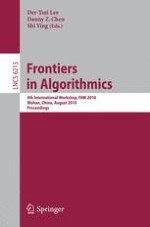2010 | Book
Frontiers in Algorithmics
4th International Workshop, FAW 2010, Wuhan, China, August 11-13, 2010. Proceedings
Editors: Der-Tsai Lee, Danny Z. Chen, Shi Ying
Publisher: Springer Berlin Heidelberg
Book Series : Lecture Notes in Computer Science
